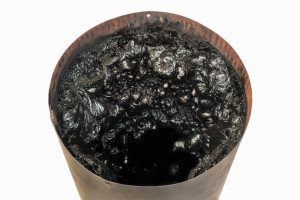All About Creosote
The last thing you want to deal with during fireplace season (or anytime, for that matter!) is a chimney fire. However, if you neglected to schedule a professional chimney sweeping before the arrival of cold weather, you may be in danger of this devastating event. As the Chimney Safety Institute of America (CSIA) states, dirty chimneys can cause chimney fires. Although soot and debris can lead to a chimney fire, the main cause of a chimney fire is creosote. Atlas Chimney would like to tell you more about creosote by answering some frequently asked questions.
 How does creosote form in my chimney?
How does creosote form in my chimney?
Creosote is a natural result from the process of burning wood. As the byproducts of combustion like smoke, gases, water vapor, hydrocarbon, tar fog, unburned wood particles, and other assorted minerals leave the fireplace and flow up into the cooler upper walls of the chimney, condensation occurs. Creosote is the result of this condensation and forms a residue that sticks to the interior walls of your chimney.
What does creosote look like?
Varying in appearance, creosote is either black or brown. Its texture can be shiny and hard, crusty and flaky, or gummy and sticky. Atlas Chimney has seen all three different textures in the same chimneys.
Why is creosote so dangerous?
No matter what creosote looks like, it is always highly combustible. If you have large accumulations of creosote deposits in your chimney, a chimney fire can be easily ignited if the flue reaches a high enough temperature.
What encourages the accumulation of creosote?
You could have a restricted air supply by closing the glass doors and failing to open the damper wide enough. Since there will not be enough make-up air to quickly move heated smoke up the chimney, the smoke and other byproducts of combustion will stay longer inside the chimney to form more creosote. Cooler than normal chimney temperatures is another related factor that leads to large deposits of creosote accumulating in your chimney. If you burn unseasoned wood, you can also end up with large amounts of creosote. Since unseasoned wood has not been fully dried, your fire uses so much energy to burn off the water that is trapped in the logs. This results in cooler smoke going up the chimney, which is much more likely to produce a large amount of creosote.
Be sure your chimney is creosote-free and ready for fireplace season! Contact us at Atlas Chimney to schedule a professional chimney sweeping today.
